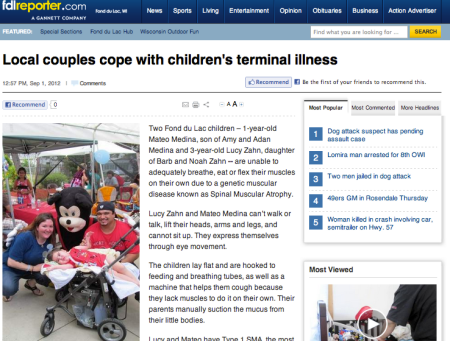FDA Week | August 23, 2012 | By Nanci Bompey
Bipartisan legislation aimed at expanding the National Institutes of Health’s investments in pediatric research through the creation of pediatric research consortia could work with newly enacted provisions in the FDA Safety and Innovation Act aimed at accelerating drug approvals, according to an advocacy group spearheading the effort. FightSMA, the group backing the legislation, is pushing for the House Energy and Commerce Committee to take up the bill when it returns from August recess.
The National Pediatric Research Network Act, introduced by Reps. Cathy McMorris Rodgers (R-WA) and Lois Capps (D-CA), directs NIH to establish a National Pediatric Research Network consisting of up to 20 pediatric research consortia over a five year period that would be eligible for awards, including grants, for basic, clinical, behavioral or translational research to meet unmet pediatric population needs, including rare diseases.
The legislation is aimed at improving clinical trials to quickly move promising drugs to approval, said Steven Eichenauer, a partner at Public Strategies Washington, who is working with FightSMA to pass the legislation.
Eichenauer added the bill would bolster research that could utilize the recently expanded accelerated approval pathway, a provision in FDASIA. He said the National Pediatric Research Network Act would help put drugs in the pipeline that can then be sent to FDA for approval, providing “a supply of newly minted therapies that have shown promise in clinical trials and are now before FDA.”
The bill would ensure these consortia focus on conducting or coordinating multisite clinical trials for pediatric rare diseases, and would establish a data coordinating center to distribute the findings, including to FDA. The consortia would be modeled after the National Cancer Institute centers and would ensure funds are dedicated exclusively towards basic and translational pediatric research and would enable inter-institutional networking, according to FightSMA. The group works to accelerate the search for a treatment and cure for spinal muscular atrophy (SMA), the leading inherited cause of infant death, according to the group.
Martha Slay, co-founder of FightSMA, said the group decided to take a broader approach with the currently introduced legislation than it has in past efforts, which focused specifically on spinal muscular atrophy.
“I consider this a really historic moment for SMA and other pediatric rare diseases, going from obscurity to a place where something significant and material could be done to make clinical trials available to children who desperately need it,” she said.
Reps. Diana DeGette (D-CO), Gregg Harper (R-MS) and Peter King (R-NY) are cosponsors and a companion bill in the Senate was introduced by Sens. Sherrod Brown (D-OH) and Roger Wicker (R-MS), and is co-sponsored by Sens. Sheldon Whitehouse (D-RI), John Kerry (D-MA), Richard Blumenthal (D-CT) and Mark Begich (D-AK).
Eichenauer said the group is pressing for consideration of the bill by the House Energy and Commerce Committee when lawmakers return to Washington in September as several sponsors sit on the panel. He said committee staff have been involved in writing the legislation and it has been vetted by the committee. “The committee knows the bill well,” he said. Further, FightSMA said House Majority Leader Eric Cantor (R-VA) is a longtime supporter of their cause.
Eichenauer said the group hopes the House could approve the legislation on the suspension calendar and then the bill could come before the Senate. Some cosponsors of the bill also sit on the Senate health committee, which FightSMA has also been working with on the legislation. Eichenauer added the group doesn’t know if the bill will move on its own or will be attached to a bigger package. Sources have said moving any legislation before the elections could be difficult.
Eichenauer said sponsors of the measure are exploring the possibility of a score from the Congressional Budget Office, but said it would not affect FightSMA’s ability to move forward with the bill. The legislation could also face difficulty with the looming “fiscal cliff.”
“There is no question that federal funding is going to be a challenge now and in the coming fiscal year,” Eichenauer said. “One of the chief advantages (of the bill), is that it does use federal dollars in a more highly-leveraged way. It takes infrastructure that is already there and expands it to leverage those dollars smartly.”
FightSMA is working over the recess to gather support in Congress and among other groups, with the Coalition for Pediatric Research, the National Down Syndrome Society and the Parent Project Muscular Dystrophy endorsing the bill. Eichenauer said sponsors have discussed reaching out to other groups, including the National Organization for Rare Disorders.




 Posted by stronwi
Posted by stronwi 











